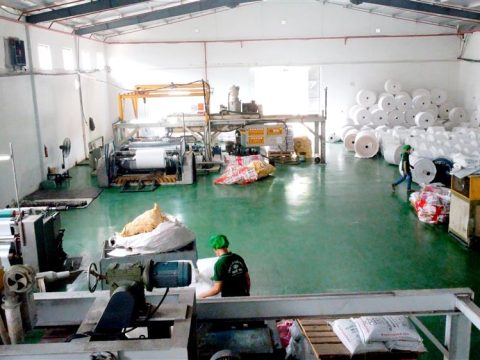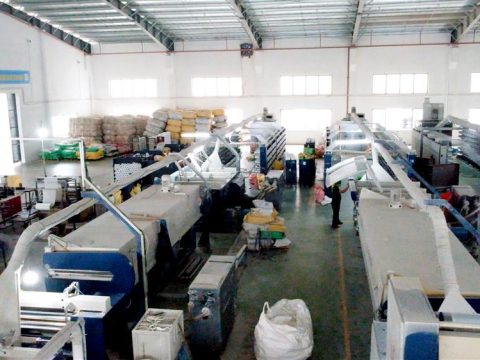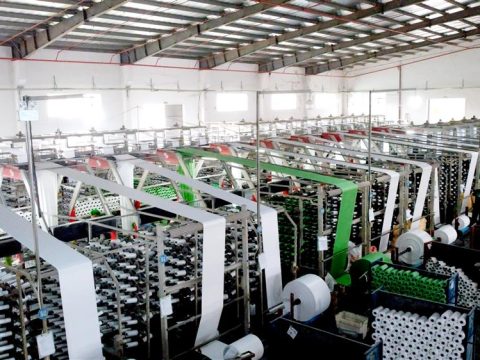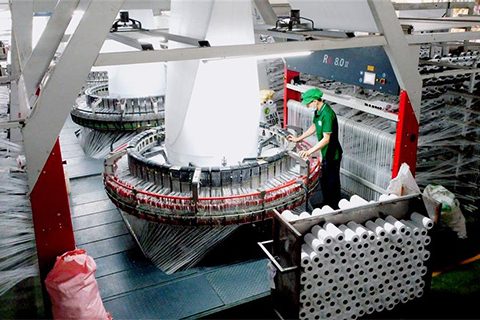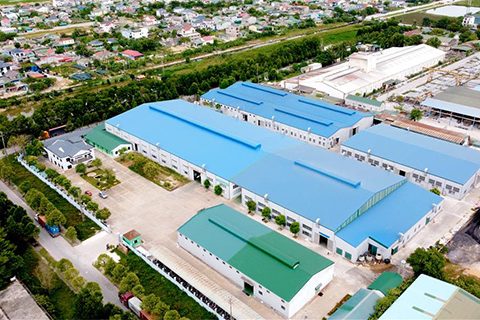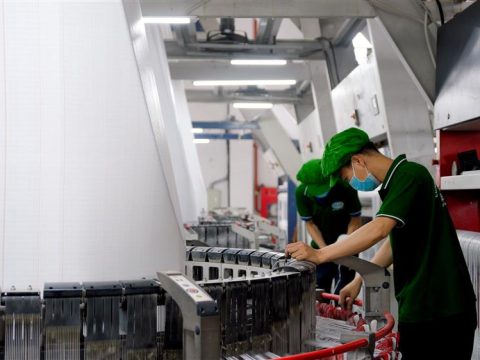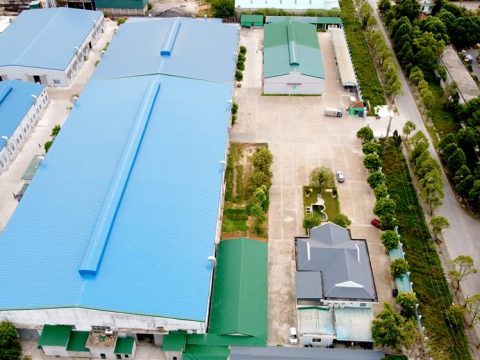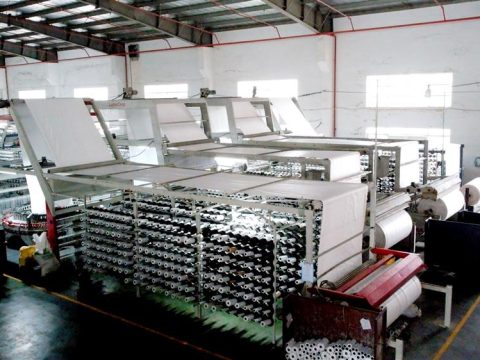Optimize Feed Storage and Transportation: Leading PP Woven Packaging and FIBC Jumbo Bag Solutions from NAPCO Vietnam
1. Introduction: The Critical Role of Packaging in Vietnam’s Dynamic Animal Feed Sector
Vietnam’s animal feed industry stands as a vital pillar supporting the nation’s agricultural development, food security objectives, and economic growth. The sector is experiencing robust expansion, fueled by rising domestic demand for meat, dairy, and aquaculture products, driven by increasing incomes and a societal shift towards protein-rich diets. This growth trajectory underscores the industry’s significance in meeting the nutritional needs of a growing population and fulfilling export ambitions.
Addressing these critical needs requires specialized packaging solutions. Polypropylene (PP) woven bags and Flexible Intermediate Bulk Containers (FIBCs), commonly known as Jumbo bags or bulk bags, have emerged as the industry standards. These packaging formats are specifically engineered to offer the durability, protection, and cost-effectiveness demanded by the animal feed sector. Their robust construction and customizable features provide reliable containment and preservation for a wide range of feed products.
2. Vietnam’s Animal Feed Industry: Growth, Trends, and Packaging Challenges
Understanding the dynamics of Vietnam’s animal feed industry is crucial for appreciating the role and requirements of packaging solutions. The sector is characterized by significant growth, evolving trends, and specific challenges that directly impact storage and transportation needs.
2.1 Market Size and Growth Trajectory
Vietnam’s animal feed market is substantial and poised for continued expansion. While specific market size valuations vary depending on the scope and methodology of different reports (ranging from approximately $1.76 billion to over $12 billion in 2024 for different segments like total feed or compound feed), the consistent narrative across analyses points to strong positive growth. Projected Compound Annual Growth Rates (CAGRs) for the coming years (typically through 2030 or 2033) range from 3.6% to 6.15%, indicating sustained upward momentum.
This growth is propelled by several key factors:
- Rising Disposable Incomes & Urbanization: Increased purchasing power and a growing urban population are leading to greater consumption of animal protein (meat, dairy, eggs, fish).
- Dietary Shifts: Consumers are increasingly shifting towards protein-rich diets for health and lifestyle reasons.
- Livestock & Aquaculture Expansion: The need to meet rising domestic and export demand is driving the expansion and intensification of livestock (particularly poultry and swine) and aquaculture farming.
- Government Support & Investment: Initiatives aimed at improving feed quality and livestock productivity contribute to market development.
Dominant segments within the industry include poultry feed, reflecting the high demand for chicken meat, and swine feed, given pork’s traditional importance in the Vietnamese diet. The aquaculture sector is also a major consumer, driving demand for specialized aquafeed. Geographically, Southern Vietnam, particularly the Mekong Delta, serves as a major hub for feed production and livestock farming, benefiting from favorable agricultural conditions and strategic location.
2.2 Key Industry Trends
Several trends are shaping the future of the Vietnamese animal feed industry and influencing packaging requirements:
- Industrialization: A significant shift is occurring from small-scale, traditional household farming towards larger, modern, commercial livestock operations. This move towards industrial farming necessitates greater efficiency in feed procurement, handling, and storage, favoring standardized and bulk packaging solutions.
- Focus on Quality and Nutrition: There is heightened awareness regarding animal health and the impact of nutrition on productivity. This drives demand for higher-quality, premium, and specialized feed formulations, including those with specific additives like probiotics and prebiotics. Protecting the integrity of these high-value feeds becomes even more critical.
- Technological Integration: Advancements in feed production technology, precision nutrition techniques, and smart livestock management systems (including IoT) are being adopted to optimize feed utilization and improve overall efficiency.
- Sustainability Focus: Growing environmental awareness is leading to exploration of alternative feed ingredients (e.g., plant-based, insect-based), sustainable farming practices, and demand for organic or antibiotic-free feed options. Packaging choices may increasingly factor in recyclability and reusability.
- Export Market Growth: Vietnam is actively working to bolster its exports of animal feed, meat, seafood, and dairy products. This necessitates adherence to international quality and safety standards, including those related to packaging and labeling.
2.3 Critical Challenges Requiring Robust Packaging
Despite the positive outlook, the industry faces significant challenges where packaging plays a crucial mitigation role:
- Raw Material Dependency and Cost Volatility: The sector relies heavily on imported raw materials like corn, soybeans, and additives, primarily from countries like Argentina and the US. This dependence makes feed manufacturers vulnerable to global price fluctuations, supply chain disruptions, and transportation costs, significantly impacting production costs and profitability. Given that feed is a major expense in livestock production, the high cost of these inputs makes minimizing any loss due to spoilage absolutely critical. Effective packaging that prevents degradation directly protects this substantial investment.
- Feed Spoilage and Quality Preservation: Animal feed is inherently semi-perishable and susceptible to spoilage from moisture absorption, leading to mold growth and nutrient degradation. Pest infestation and oxidation further compromise quality. Maintaining the intended nutritional value from the factory to the animal is essential for farm productivity and profitability. Packaging must provide a robust barrier against these environmental threats.
- Logistics and Infrastructure Gaps: While improving, Vietnam’s logistics infrastructure, particularly for temperature-sensitive goods but also impacting general transport efficiency, can be fragmented and underdeveloped in certain regions. This can lead to delays, increased handling, and potential damage to packaged goods. High energy costs for transportation and storage also add to the operational burden. Durable packaging that can withstand handling stress and protect contents during potentially long or challenging transit is vital.
- Biosecurity and Contamination Risks: Outbreaks of diseases like African Swine Fever (ASF) have highlighted the critical importance of biosecurity throughout the feed and livestock supply chain. Packaging must provide a secure barrier to prevent cross-contamination from pathogens, pests, or other environmental contaminants, safeguarding both animal health and potentially human food safety.
The convergence of industrialization, focus on quality, export ambitions, and the persistent challenges of cost volatility and spoilage risk elevates packaging from a simple container to a strategic component for success in the Vietnamese animal feed market.
3. Optimal Packaging Solutions: Poly Woven (PP) Bags and Bulk Bags (FIBCs)
To effectively address the diverse needs and challenges of the Vietnamese animal feed industry, specific packaging formats have become prevalent due to their inherent advantages. Polypropylene (PP) woven bags and Flexible Intermediate Bulk Containers (FIBCs), or Jumbo bags, offer tailored solutions for protecting feed quality, enhancing operational efficiency, and managing costs.
3.1 Why PP Woven and FIBCs are Ideal for Animal Feed
These packaging types are favored because they effectively meet the core requirements of the industry:
- Protection: They provide barriers against moisture, pests, UV radiation (with additives), and physical contamination.
- Durability: They are designed to withstand the stresses of handling, stacking, and transportation.
- Cost-Effectiveness: They offer favorable material costs and help minimize product loss due to spoilage or damage.
- Efficiency: They facilitate efficient filling, closing, handling, storage, and discharge processes.
- Branding: They provide surfaces suitable for printing essential product information and brand messaging.
3.2 Poly Woven (PP) Bags – Versatile and Reliable
PP woven bags are a mainstay for packaging finished animal feed in various standard weights.
- Material: Constructed by weaving extruded polypropylene tapes, these bags are inherently strong, lightweight, and resistant to tearing and puncturing. While naturally breathable, this property can be modified through coatings or liners for specific applications.
- Key Advantages:
- Durability: The woven structure provides an excellent strength-to-weight ratio, ensuring bags resist breakage during manual and automated handling, stacking, and transport. They can withstand the pressures involved in filling and closing processes.
- Moisture Resistance: This is a critical factor for feed preservation. Moisture protection can be significantly enhanced by applying a PP coating or lamination, or by incorporating an inner Polyethylene (PE) liner. These additions create a barrier against humidity and water ingress.
- Cost-Effectiveness: PP woven bags generally offer a lower packaging cost compared to alternatives like multi-wall paper sacks, especially when considering their durability and protective qualities. Their lightweight nature also contributes to lower freight costs.
- Printability for Branding: The outer surface provides a good canvas for branding and conveying essential information. Options range from cost-effective Flexo printing for basic logos and text to high-resolution Gravure printing on Biaxially Oriented Polypropylene (BOPP) laminated bags. BOPP lamination offers superior graphic quality, making brands stand out, and crucially, protects the print from abrasion and fading during handling. This is vital for premium products or those destined for export markets requiring clear, durable labeling.
- Customization: A major advantage is the high degree of customization available. Bags can be produced in various sizes (commonly 20kg, 25kg, 40kg, 50kg for feed), colors, fabric weights, and weave patterns (e.g., anti-skid weaves for better stack stability). Numerous construction options exist for the top (e.g., heat cut, cold cut, hemmed, valve top, easy-open features) and bottom (e.g., single/double fold, single/double stitch). Gussets can be added for a more box-like shape, and handles can be incorporated for easier carrying.
- Types for Feed: Standard PP woven bags, often enhanced with a PE liner or PP coating, provide a reliable and economical solution for many feed types. For applications demanding superior moisture protection, exceptional print quality, and enhanced durability, BOPP laminated PP woven bags represent a premium option. The choice depends on the specific feed product’s value, sensitivity, target market, and branding strategy.
3.3 Bulk Bags (FIBCs / Jumbo Bags) – Efficiency at Scale
FIBCs, or Jumbo bags, are designed for handling materials in large volumes, typically ranging from 500kg to 2000kg or more.
- Material: Like smaller woven bags, FIBCs are constructed from heavy-duty woven polypropylene fabric, engineered to safely contain and transport substantial weights.
- Key Advantages:
- Bulk Handling Efficiency: FIBCs dramatically reduce manual labor and increase the speed of loading, unloading, and transporting large quantities of feed ingredients (like grains, meals, pellets) or finished feed for large-scale operations. They are designed for mechanical handling using forklifts or cranes via integrated lifting loops.
- Cost Savings: For bulk volumes, FIBCs offer a significantly lower packaging cost per kilogram compared to using numerous small bags. They optimize shipping container and truck space, reducing transportation costs. Product loss during handling and transit is also minimized due to the robust, single-container format
- Space Efficiency: FIBCs are generally stackable, optimizing warehouse storage space. Baffled FIBCs contain internal panels that help the bag maintain a squarer shape, preventing bulging and improving stacking stability and efficiency.
- Durability & Safety: These bags are engineered for strength and safety, manufactured to meet specific Safe Working Load (SWL) requirements and Safety Factors (SF). An SF of 5:1 is standard for single-trip bags, while an SF of 6:1 indicates a design suitable for multiple uses (with proper inspection and handling). Options for UV stabilization enhance durability for outdoor storage.
- Product Protection & Customization: FIBCs can be customized with various filling and discharge options to suit different products and handling systems. Common top options include open tops, filling spouts, or duffle tops (skirt covers), while bottom options include flat bottoms or discharge spouts for controlled emptying. Liners made from PE or even foil can be inserted to provide enhanced moisture protection, oxygen barriers, or meet food-grade standards.
- Applications in Feed: FIBCs are extensively used for storing and transporting bulk raw ingredients (corn, soybean meal, fish meal, minerals, additives) delivered to feed mills. They are also used for internal transfer of materials within large production facilities and, increasingly, for delivering bulk quantities of finished feed directly to large commercial farms equipped for bulk handling.
The selection between standard PP woven bags, premium BOPP laminated bags, or high-capacity FIBCs depends on a careful assessment of the specific application. Factors include the value and sensitivity of the feed product, required shelf life, the sophistication of handling and storage systems at both origin and destination, branding requirements, and whether the product is for domestic consumption or export. Furthermore, the growing importance of sustainability favors packaging solutions that are durable, reusable (like multi-trip FIBCs), and recyclable, such as polypropylene. Offering a comprehensive range allows feed producers to choose the most operationally efficient and cost-effective solution for each unique need.
4. NAPCO: Your Premier Vietnamese Partner for Animal Feed Packaging Solutions
Choosing the right packaging supplier is as critical as choosing the right packaging type. Nghe An Packaging Joint Stock Company (NAPCO) emerges as a strong contender, offering a compelling combination of local manufacturing presence, extensive experience, significant capacity, adherence to international standards, and a product portfolio tailored for the animal feed industry.
4.1 NAPCO’s Credentials and Capabilities
NAPCO brings substantial credibility and resources to the table:
- Experience and Reputation: Founded in 2003, NAPCO possesses over two decades of experience, initially serving the demanding Vietnamese domestic market before successfully expanding its reach globally since 2017. It is recognized as a leading manufacturer of PP woven and Jumbo bags in Vietnam.
- Significant Production Capacity: With the capability to produce over 6 million PP woven bags and 120,000 Jumbo bags per month, NAPCO can reliably fulfill large-volume orders and ensure consistent supply for its customers. The factory operates continuously (24/7) to meet demand.
- Modern Technology: NAPCO utilizes modern production machinery sourced from reputable international manufacturers, including Starlinger (Austria), LOHIA (India), and Hengli (China), ensuring efficient and high-quality output.
- Robust Quality Assurance: Critically important for the feed industry, NAPCO holds key international certifications: ISO 9001:2015 for Quality Management Systems and ISO 22000:2018 for Food Safety Management Systems. HACCP principles are also mentioned. These certifications demonstrate a commitment to rigorous quality control and safety protocols throughout the manufacturing process, providing essential assurance for feed packaging applications.
- Strategic Location: Situated in Nghe An province in central Vietnam, NAPCO is well-positioned to serve the entire domestic market efficiently. Its proximity (300 km) to Hai Phong port facilitates cost-effective logistics for its significant export operations.
- Operational Scale: Employing a workforce of 301-500 people underscores the company’s substantial operational scale and capacity.
- Global Reach: Exporting 60% of its production to international markets (including Malaysia, Thailand, Singapore) demonstrates NAPCO’s ability to meet diverse global standards and customer requirements.
4.2 NAPCO’s Tailored Poly Woven Bags for Animal Feed
NAPCO offers a dedicated range of PP woven bags suitable for animal feed packaging:
- Product Portfolio: The company explicitly lists PP woven bags for animal feed among its core products. This includes standard PP woven bags, likely available with coating or liners, and BOPP laminated bags for superior print quality and protection (inferred from general BOPP bag offerings and market needs).
- Customization: Recognizing diverse customer needs, NAPCO provides extensive customization. This includes varying sizes (capable of holding 10-100kg ), fabric colors, Flexo printing on 1-4 sides in multiple colors , options for coating and liners for moisture proofing, and different top/bottom constructions (heat cut, hemmed, drawstring, single/double fold/stitch). NAPCO emphasizes its ability to develop products precisely matching client specifications.
- Quality Focus: NAPCO commits to delivering high-quality products consistently through established quality control procedures, aiming for the best price on the market. While options for recycled PP exist , the availability of 100% virgin PP is crucial for feed applications requiring direct contact safety.
(Relevant search terms: animal feed PP woven bag, BOPP bag)
4.3 NAPCO’s Robust Bulk Bags (FIBCs) for the Feed Industry
For bulk handling needs, NAPCO manufactures durable FIBCs:
- Product Portfolio: Jumbo bags (FIBCs/Bulk bags) are a primary product line, suitable for agricultural applications including storing and transporting raw materials used in animal feed production. These bags can handle loads up to 2000kg and beyond.
- Construction & Design: NAPCO offers FIBCs made from coated or uncoated PP fabric and can likely produce various standard constructions (U-panel, 4-panel, circular) based on industry norms and their customization capabilities.
- Safety and Durability: Production adheres to required safety standards, encompassing Safe Working Load (SWL) and Safety Factor (SF) specifications. They can likely provide both 5:1 (single-trip) and 6:1 (multi-trip) SF bags to meet different operational needs.
- Customization: FIBCs are highly customizable in terms of dimensions, fabric weight, lifting loop configurations, and top/bottom designs (e.g., filling spouts, discharge spouts) to align with specific products and handling equipment. Liner options are likely available for enhanced protection.
(Relevant search terms: FIBC Jumbo bag NAPCO, Animal feed bulk bag)
Table: NAPCO Vietnam: PP Woven & FIBC Bag Specifications for Animal Feed Applications
| Feature | PP Woven Bags (NAPCO) | FIBC (Jumbo) Bags (NAPCO) |
|---|---|---|
| Material | Woven Polypropylene (Virgin options available) | Heavy-Duty Woven Polypropylene (Virgin options available) |
| Typical Capacity | 10kg – 100kg | 500kg – 2000kg+ |
| Construction Options | Standard, PP Coated, BOPP Laminated | U-Panel, 4-Panel, Circular (Customizable) |
| Liner Options | Yes – PE (for moisture proofing) | Yes – PE Liners (Likely available) |
| Printing Options | Flexo (up to 4 colors, 1-4 sides) , BOPP Gravure | Limited printing typically required; custom options available |
| Top/Bottom Options | Heat Cut, Hemmed, Valve, Easy Open, Drawstring | Filling Spout, Duffle Top, Open Top / Discharge Spout, Flat Bottom (Customizable) |
| Safety Factor (FIBC) | N/A | 5:1 (Single-Trip), 6:1 (Multi-Trip) (Likely available) |
| Key Certifications | ISO 9001:2015, ISO 22000:2018 | ISO 9001:2015, ISO 22000:2018 |
4.4 NAPCO’s Value Proposition – Why Choose NAPCO?
Partnering with NAPCO offers distinct advantages for businesses in the Vietnamese animal feed sector:
- Local Expertise, Global Standards: NAPCO combines an intrinsic understanding of the Vietnamese market dynamics with adherence to internationally recognized quality (ISO 9001) and food safety (ISO 22000) standards, further validated by significant export experience. This unique blend offers local accessibility coupled with global quality assurance.
- Reliability and Capacity: The company’s substantial production capacity and 24/7 operations provide assurance of supply continuity and the ability to handle large, time-sensitive orders. Their commitment to speedy delivery further enhances supply chain reliability.
- Uncompromising Quality and Safety: The ISO 22000 certification is a critical differentiator, particularly as feed safety gains prominence. It provides customers with objective evidence of rigorous controls over materials, hygiene, and processes, mitigating risks of contamination and ensuring packaging is suitable for feed applications. This aligns perfectly with the industry’s increasing focus on quality and biosecurity.
- Competitive Pricing: As a large-scale domestic manufacturer, NAPCO aims to deliver high-quality packaging solutions at competitive market prices, potentially offering cost advantages compared to imported alternatives or smaller local suppliers.
- Customer-Centric Service: NAPCO’s philosophy emphasizes creating value for customers, offering services like custom product development and after-sale support. Direct access to sales management ensures responsive communication.
NAPCO represents a strategic choice for Vietnamese feed producers seeking a reliable, high-capacity domestic supplier capable of delivering internationally certified quality and customized solutions at competitive prices.
5. Enhancing Your Operations: The Tangible Benefits of Partnering with NAPCO
Selecting NAPCO as a packaging partner translates into concrete operational and financial advantages for animal feed businesses in Vietnam. By leveraging NAPCO’s specialized PP woven and FIBC bag solutions, companies can directly address key industry challenges and improve their bottom line.
NAPCO’s packaging effectively tackles critical pain points:
- Combating Feed Spoilage & Quality Loss: The high-quality woven polypropylene material, combined with options for moisture-resistant coatings and PE liners, provides a robust barrier against humidity, a primary cause of mold and degradation. Durable construction minimizes the risk of punctures or tears that could expose feed to pests or contaminants. Furthermore, NAPCO’s adherence to ISO 22000 standards provides an extra layer of confidence in the safety and integrity of the packaging itself.
- Mitigating Cost Pressures: By significantly reducing feed spoilage, NAPCO’s packaging helps preserve valuable raw materials and finished products, directly cutting waste-related costs. The inherent cost-effectiveness of PP woven bags and the handling efficiencies gained from FIBCs contribute to lower overall packaging and logistics expenses. As a competitive animal feed packaging supplier based locally, NAPCO offers potentially advantageous pricing.
- Improving Logistics and Handling: The strength and resilience of NAPCO’s bags minimize product loss due to package failure during transit and handling. FIBCs streamline the movement of bulk materials, reducing loading/unloading times and labor requirements. NAPCO’s large production capacity ensures a reliable supply chain, preventing costly operational disruptions due to packaging shortages.
- Strengthening Branding and Market Appeal: NAPCO offers high-quality printing options, including vibrant BOPP lamination, enabling companies to effectively display their brand, communicate essential product information, and create packaging that stands out on the shelf. This is crucial for building brand recognition and conveying product quality in a competitive market.
Choosing NAPCO yields quantifiable advantages:
- Reduced Waste and Costs: Lower incidence of feed spoilage translates directly to cost savings. Durable packaging minimizes losses from damaged bags.
- Improved Operational Efficiency: Faster and safer handling, particularly with FIBCs, optimizes labor and equipment utilization. Easier storage and streamlined logistics reduce operational bottlenecks. Finding bao jumbo giá tốt (good price jumbo bag) combined with efficiency gains maximizes ROI.
- Enhanced Product Integrity and Safety: Consistent feed quality reaches the end-user, supporting animal health and productivity. Packaging meets safety standards (ISO 22000), bolstering biosecurity measures.
- Stronger Brand Presence: Professional, durable, and visually appealing packaging enhances brand perception and customer trust. high-quality PP woven bag reflects positively on the product inside.
- Supply Chain Reliability: Partnering with Nghe An Packaging Joint Stock Company ( NAPCO ), a major manufacturer with proven capacity, provides peace of mind and ensures packaging availability when needed.
Ultimately, partnering with NAPCO is more than just purchasing bags; it’s a strategic decision to invest in operational excellence, quality assurance, risk management, and brand enhancement within the dynamic Vietnamese animal feed landscape.
6. Conclusion: Secure Your Feed Quality and Business Growth with NAPCO Vietnam
The Vietnamese animal feed industry presents significant opportunities, driven by strong domestic demand and growing export potential. However, navigating challenges related to cost volatility, quality preservation, and logistical complexities is essential for sustained success. In this context, high-performance packaging is not merely a cost but a critical enabler of quality, efficiency, and profitability. PP woven bags and FIBC Jumbo bags stand out as the optimal solutions, offering the necessary protection, durability, and handling characteristics.
Nghe An Packaging Joint Stock Company (NAPCO) has established itself as a premier Vietnamese manufacturer, uniquely positioned to serve the specific needs of the animal feed sector. With decades of experience, substantial production capacity, modern technology, and crucially, adherence to international quality (ISO 9001) and food safety (ISO 22000) standards, NAPCO delivers reliable and effective packaging solutions. Their commitment extends to providing customized PP woven and Jumbo bags tailored to each client’s requirements.
By choosing NAPCO, animal feed producers, raw material suppliers, and large-scale farms gain a partner dedicated to enhancing product protection, improving operational efficiency, managing costs effectively, and ensuring supply chain security. NAPCO embodies its philosophy of “Creating new Values for Customers” , striving to be more than just a supplier, but a contributor to your business success.
Take the next step towards optimizing your animal feed packaging. Secure the quality of your products and support your business growth by partnering with a leader in Vietnamese packaging manufacturing.
Contact NAPCO today for inquiries, consultations, or custom design requests:
- Website: https://vietnamjumbobag.com/ ; https://napco.com.vn/
- Email: Dien@napco.com.vn
- Phone: +84 98 549 5345
- WhatsApp: +84 98 549 5345
- WeChat: Via QR Code on website
- Line: Via Link/QR Code on website
- Viber: Via QR Code on website
- Factory/Office Address: Road N2 Bac Vinh Industrial Park, Hung Dong Commune – Vinh City – Nghe An – Vietnam


